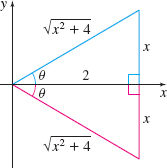EXAMPLE 5Integrating a Rational Function Whose Denominator Contains a Repeated Irreducible Quadratic Factor
Find ∫x3+1(x2+4)2dx.
Solution The denominator is a repeated, irreducible quadratic, so the decomposition of x3+1(x2+4)2 is x3+1(x2+4)2=Ax+Bx2+4+Cx+D(x2+4)2
505
Clearing fractions and combining terms give x3+1=(Ax+B)(x2+4)+Cx+Dx3+1=Ax3+Bx2+(4A+C)x+4B+D
Equating coefficients, we get A=1B=04A+C=04B+D=1C=−4D=1
Then x3+1(x2+4)2=xx2+4+−4x+1(x2+4)2
and ∫x3+1(x2+4)2dx=∫xx2+4dx+∫−4x+1(x2+4)2dx=∫xx2+4dx−4∫x(x2+4)2dx+∫dx(x2+4)2
In the first two integrals on the right in (3), we use the substitution u=x2+4 , x≥0. Then du=2xdx, and
In the third integral on the right in (3), we use the trigonometric substitution x=2tanθ, −π2<θ<π2. Then dx=2sec2θdθ, and ∫dx(x2+4)2=∫2sec2θdθ(4tan2θ+4)2=216∫sec2θdθ(sec2θ)2=18∫cos2θdθ=18∫1+cos(2θ)2dθ=116[θ+12sin(2θ)]=116(θ+sinθcosθ)
To express the solution in terms of x, either use the triangles in Figure 10 or use trigonometric identities as follows: sinθcosθ=sinθcosθ⋅cos2θ=tanθsec2θ=tanθtan2θ+1=x2x24+1=2xx2+4
Then ∫dx(x2+4)2=116(θ+sinθcosθ)=↑x=2tanθ;θ=tan−1x2116(tan−1x2+2xx2+4)

Now use the results of (3), (4), (5), and (6): ∫x3+1(x2+4)2dx=12ln(x2+4)+2x2+4+116tan−1x2+x8(x2+4)+C1